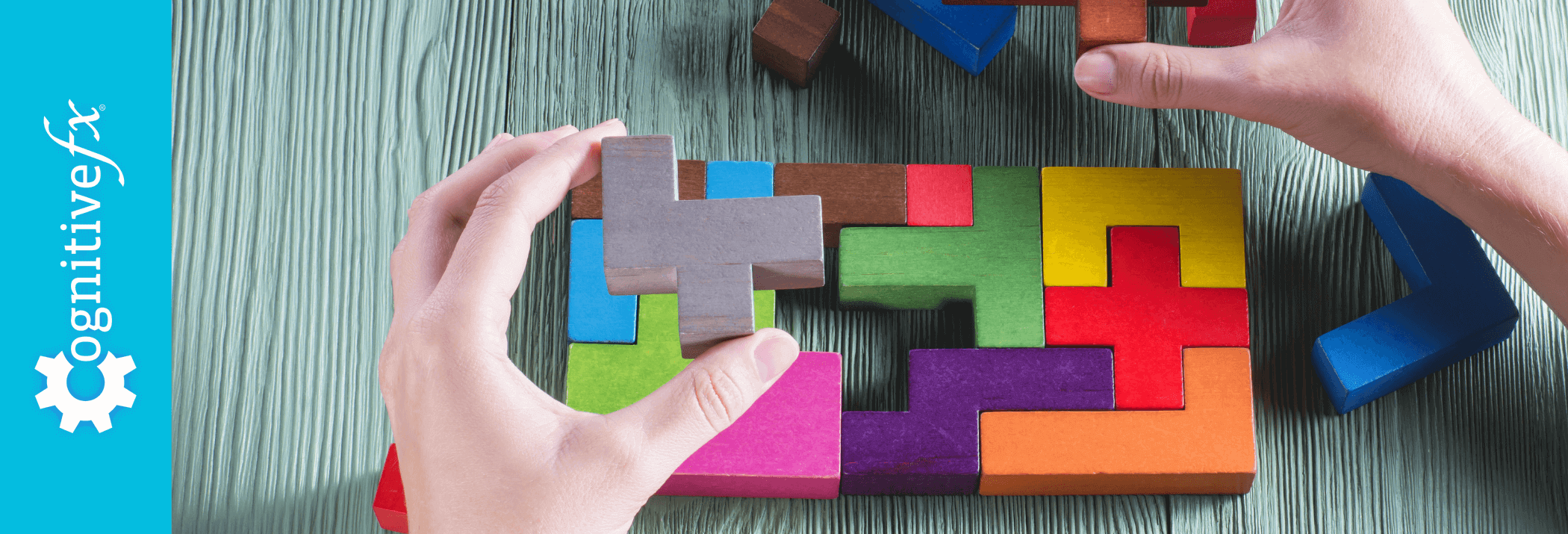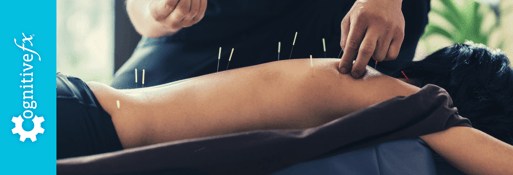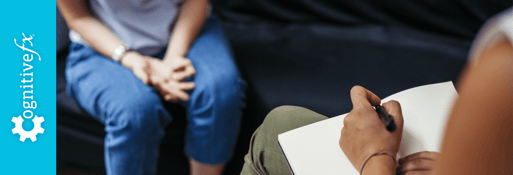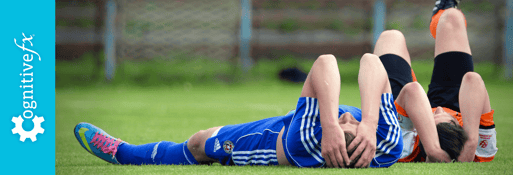If you’ve had a severe or mild traumatic brain injury (severe TBI or mild TBI) that’s left you with post-concussion syndrome (PCS), just thinking can be taxing. Cognitive health is “the ability to clearly think, learn, and remember,” but a brain injury can disrupt these processes, either temporarily or in the long term. This can make day-to-day functioning a challenge, to say the least.
For someone struggling with these kinds of cognitive impairments, that might look like trying to describe your favorite TV show to a family member but suddenly forgetting all of the characters’ names.
Perhaps returning to work feels impossible since 10 minutes of face-to-face conversation completely drains your battery, because your social skills and communication skills may have become more difficult.
Or maybe simply reading a book is no longer enjoyable because attention deficits cause your focus to drift elsewhere no matter how much you try to concentrate on the words on the page.
Fortunately, cognitive therapy can be a huge help to those dealing with thinking, learning, and memory problems due to a brain injury or concussion.
In this post, we’ll explain:
If you or a loved one are suffering from lingering symptoms after a traumatic brain injury, you’re not alone. We can help. 95% of our patients experience statistically verified restoration of brain function. Their symptoms improve, on average, by 75% in just one week. Book a consultation with our team to learn if you are eligible for treatment.
Note: Any data relating to brain function mentioned in this post is from our first generation fNCI scans. Gen 1 scans compared activation in various regions of the brain with a control database of healthy brains. Our clinic is now rolling out second-generation fNCI which looks both at the activation of individual brain regions and at the connections between brain regions. Results are interpreted and reported differently for Gen 2 than for Gen 1; reports will not look the same if you come into the clinic for treatment.
What Cognitive Rehabilitation Therapy Is
Cognitive therapy, also called cognitive rehabilitation therapy, is a kind of brain injury rehabilitation program focused on improving areas of cognition, such as memory, attention, problem solving, organization, executive function skills, and word finding. A cognitive therapist will guide you through exercises designed to improve those abilities.
Speech-language pathologists work in this realm. Many people may think SLPs only work on speech issues, such as articulation or communication disorders, but they’re also trained in voice, fluency, social communication, swallowing disorders, and cognitive communication.
Cognitive communication is the area that includes memory, attention, problem solving, organization, and other thinking skills.
Cognitive therapy doesn’t cover certain other issues you might face post-injury, such as vision, balance, mobility, cardiovascular exercises, or any kind of body work such as massage or stretching you might do with a physical therapist or occupational therapist.
It also isn’t occupational therapy, which — though it does focus on an individual’s ability to complete daily tasks, either at home or for work — focuses more on adapting the person’s environment or task to fit them.
Finally, cognitive therapy is also not cognitive behavior therapy, or CBT. That kind of therapy is a mental health therapy provided by a psychotherapist or therapist and which works on improving negative or inaccurate thinking habits, which can result in behavioral changes.
While CBT or psychotherapy may be helpful for some patients with TBI or PCS, cognitive behavioral therapy is a different mode of therapy and should be sought out separately from cognitive rehabilitation therapy, which focuses on improving cognitive skills such as memory and attention.
How Cognitive Therapy Works and What We Do
The most common cognitive impairments we see in brain injury and concussion patients are usually related to memory, attention, executive functioning, and word finding, so much of our therapy work is spent focusing on those areas of cognition.
Memory Exercises for TBI

Memory is more complex than just being able or unable to remember something. We need to acquire information through the senses, process that information, store it, and retrieve it. A problem with any one of these steps can affect your short-term and long-term memory.
Therapy exercises are designed to help with each part of the process and reduce your dependency on compensatory strategies like writing everything down and relying on written lists to remember something.
During a cognitive therapy session, working on short and long-term memory may be as simple as having you read an informational paragraph with us. The selection is random and can be facts about Niagara Falls, or a historical occurrence, for example, where you answer questions about it afterward.
Then within the cognitive therapy hour on that same day, we’ll have you recall some of the details from the article.
During your next cognitive therapy session, we will follow up on the article you read, and, specifically, the details you stored, and have you focus on the retrieval of those details. This allows for you to retrieve information after time has passed since first learning (and storing) it.
Another way we might challenge growth for this type of memory is to give you a list of words we want you to recall at a later time. If you are currently struggling with cognitive function, you might think, “Oh, I’ll never remember that list!” But, remember, a cognitive therapist will be there to guide you through this process. So rather than just having you memorize that list, we’ll ask you to create a story using those words. This helps you make associations with the words to link them together. Then, we’ll ask you to come up with a title for the story.
When we ask you to recall those words later, it might seem difficult at first — but if needed, we will give you a general clue or tell you the title, that serves as a sort of key to the door that leads to retrieval of the story you created, which helps you recall the words we asked you to remember.
Exercises like this can be helpful in recalling items you wouldn’t normally associate with each other. For instance, if you knew you needed to get a specific list of things from the grocery store, such as tomatoes, cilantro, lettuce, sour cream, cheese, and bananas, it might be easier to recall your list if you group them as “five things I need to make tacos, plus bananas.”
Another kind of memory we work on is called working memory. Working memory is the part of our memory that combines temporary storage (seconds to a few minutes) of information and processing or manipulation of that information.
This is the type of memory we use when we’re dialing a new telephone number, or when we leave one room to go into another room to get something, and we’re able to recall why we entered the new room.
Another example of working memory may be while you’re at the grocery store shopping for taco ingredients and bananas, you might keep a running total in your head of how much money your bill will be at checkout. That would require remembering a new total each time you add another item to your cart, and hanging on to that total in your head just until the next item gets added. Then you hang on to that new number, and so on.
Working memory is also important in conversations or while attending a meeting. As we listen to a friend talk or listen to information provided in a meeting, we hold on to what is being said and process the meaning of what is being presented to us.
With how often we rely on our memory and working memory for daily activities, you can imagine how fatiguing it might be if the areas of the brain responsible for these skills are not working as efficiently as they should be.
Part of what we do at Cognitive FX is to help strengthen the areas of the brain responsible for memory, just like a muscle.
But part of the therapy is also learning strategies for how to remember things when that muscle still seems weak.
So, while going through these exercises might make recall more automatic, we also want to teach you tips and tricks for how to recall things even if it isn’t automatic yet.
With time and continued practice, the automatic “muscle” of your memory should improve, too.
Attention Exercises for TBI
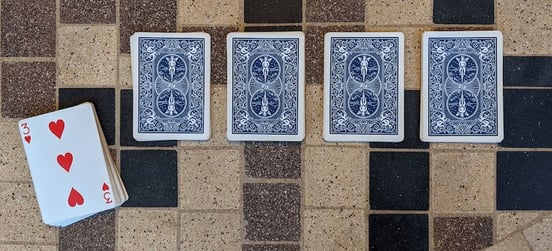
Just like there are different types of memory, there are also different types of attention: selective attention, divided attention, and sustained attention.
Selective attention is the kind of attention it takes to focus on only one thing and filter out various environmental distractions, such as noise. This is the kind of attention we use when speaking with a friend in a noisy restaurant, and we only want to focus on what our friend is saying.
An exercise for selective attention involves having you tap whenever you hear a pair of opposite words in a continuous list (such as ‘room’ ‘hot’ ‘cold’ ‘bear’ ‘door’), but with news radio playing in the background. The goal is to focus only on the task at hand, even though there might be a lot going on around you.
Divided attention is the ability to do two or more things at once. This is an interesting concept in and of itself, since we can’t actually do two things at once — what we’re really doing is quickly switching our focus back and forth between two things.
Plenty of us have some tasks so well learned that we assume we don’t have to think about them to do them, but we’re still actually giving that task some of our attention.
An example might be driving and talking at the same time. As we become more experienced drivers, we might be able to maintain speed without giving too much of our active attention to the act of driving, giving us the ability to also speak with a passenger. But when a driver is new to the task, they might be shocked to realize they’ve slowed 20 mph just from telling you about their day.
For example, one exercise we do to strengthen divided attention is to have you sort cards into their suits, with the cards face down (after memorizing which suit goes where) while we ask you to give an acronym for each word we say (if we say “up” you say “down,” and so forth).
Sustained attention is how well you can focus on something for a longer period of time. If you are doing particularly well at sorting and naming, or during another type of cognitive exercise, we might have you do it for an extended period of time, just to help challenge your attention capabilities to function longer. These tasks can be fatiguing, so additional exercise in these areas can help lengthen how long you can keep them up.
Other Cognitive Exercises

Based on the specific needs of each patient, we also work on cognitive skills like executive functioning (think decision-making and reasoning skills).
For example, you may be given problem-solving tasks like logic puzzles. Working on deduction puzzles can help strengthen decision-making and reasoning skills, which are valuable for many life situations. These types of puzzles require you to make deductions, look for specific details, figure out a plan on how to approach solving the puzzle, and if something is not working, being able to look at the puzzle in a different way and change your approach.
We will also work on word retrieval with patients who are struggling with word finding skills. We may do this through naming exercises where we have you come up with different items that belong in a given category.
For example, we might ask you to list three fruits or list three things that are hot. We may also help guide you in word finding exercises by having you describe objects by their attributes to help you identify the specific word you are looking for.
The Goldilocks Approach: How Therapy Varies Based on Severity of TBI
Although a cognitive therapist will provide treatment to patients targeting similar cognitive skills, the therapy is customized for the unique needs of each individual patient.
While every brain injury (severe or mild) may share similar features, the way it is expressed and the way therapy needs to be applied is different for everyone.
The skill of the cognitive therapist is to know how to approach each patient in a way that provides a healthy challenge for them. A healthy challenge will require effort and push your limits, but will stay within the realm of tolerance.
There’s a Goldilocks approach that needs to be taken — rather than doing an exercise that is too difficult or too easy, your therapist wants to gauge where you are to ensure your treatment is just right for what you specifically need. The following is an example of how this approach was applied at our clinic.
A patient came into Cognitive FX struggling to make eye contact after saying “Hi.” Anything beyond that was a huge struggle. Because of post-concussion syndrome, their brain was having to focus so much on holding a conversation that it was overwhelming to focus on another person’s face and interact with them verbally.
Making eye contact normally was one of their treatment goals, so during the third cognitive therapy session, we added a parameter to treatment: Making eye contact during therapy.
Since this added difficulty, we reduced the difficulty of the other exercises to start. For example, instead of rearranging five-word sentences alphabetically, we would assign three-word sentences to be rearranged while making eye contact.
Soon, this patient was able to complete the five-word sentence task and maintain eye contact. After moving on to another task that went well, the patient broke down in tears, happy to know how much progress they made in such a short amount of time.
What to Look for in a Cognitive Therapist

If you’re looking for a cognitive therapist in your area, look for a speech- language pathologist who specializes in cognition therapy after brain injury. This person should be trained to work on memory, attention, and executive functioning.
Seek out a therapist who makes you feel comfortable working with them, and who realizes you have an invisible, cognitive functioning injury that may take a lot of effort on your part to heal.
Some therapists may be accustomed to working with patients who are demonstrating more visible symptoms, so they may automatically be attuned to helping a patient with basic daily living functions. If you have a milder head injury (i.e., you can still feed yourself, but you can't remember your grocery list, or it takes you three hours to make a simple brownie recipe, etc.) they may not think you need treatment. They might call your symptoms “subclinical” ... but that doesn't mean that they aren't impacting your life in a major way. It just means some doctors and therapists won't treat you. Try not to get discouraged by this, and find the ones who will.
You also want a therapist to help you grow. If they’re too easy on you, you may not accomplish much in your time together, and if they push too hard, you may become too easily fatigued and feel like the uphill battle is too steep.
After a therapy session, you should feel like you’ve had a good workout, and that you’ve made some progress. So if you feel too exhausted to function after a session, or feel as though you haven’t progressed at all, you may want to try other therapists.
How to Manage Cognitive Fatigue at Home
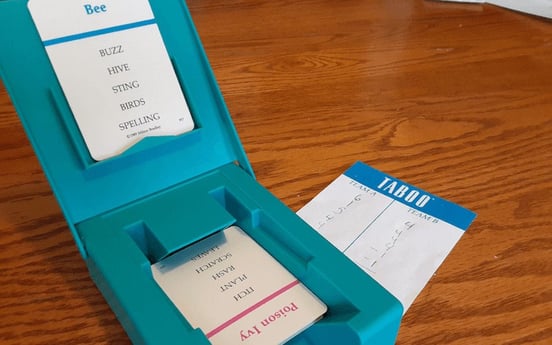
Whether you’re actively exercising your brain or simply trying to get through the day, you may find yourself overly fatigued from cognitive exertion, since even non-physical cognitive activity can still be exhausting.
Whether you’ve already been to our clinic or you just want some exercises to do at home to improve your quality of life, there are a few things we recommend.
Here are a few tips to help you avoid feeling too run down just from trying to function:
Play Cognitive Games
If you’ve already been to our Provo, Utah clinic, it’s a great idea to keep doing the exercises we taught you there, either by yourself or with a partner.
If you haven’t been to us for treatment, there are still plenty of exercises you can try on your own. For example, make a list of five words to memorize today, and then try to recall them tomorrow. Then add a few more words, and try to remember the longer list the following day.
Another good exercise is to take all the words in a sentence and (solely in your head; no cheating with pen and paper!) rearrange the words into alphabetical order. For a challenge, try to arrange them in reverse alphabetical order.
Another option is to play app games on a phone, tablet, or computer. Games such as sudoku, crosswords, Scrabble, Wordscapes, or deduction puzzles can all help with cognition.
For more ideas, read our post: 17 Cognitive Exercises for Post-Concussion Syndrome You Can Do at Home
Pace Yourself and Plan Breaks
If you know you have a lot of cognition-heavy tasks to accomplish in any given day, pace yourself. Consider spreading them throughout the day with ample periods between for rest, or for easier, less stressful activities.
Additionally, try not to take on too much in general. If you feel yourself getting overwhelmed, or if you know you can bump a particular task to the following day, allow yourself to do so. You still have an injury, even if it’s invisible, so be kind and patient with yourself.
Besides pacing yourself, plan ahead to take “thinking breaks” throughout your day when you can do something that doesn’t require as much cognitive power. If you need to, set a timer on a device such as your phone or smart watch to remind you to get up and walk around, take deep breaths, stretch, drink water, and have a snack. This can help you both rest and restore between tasks that require heavier mental lifting.
Eat and Drink Well
It’s always important to ensure you’re eating well and drinking plenty of water, but this is even more important when you’re struggling with the effects from a TBI or post-concussion syndrome. Our brains need regular doses of water, protein, lipids (fats), carbohydrates, antioxidants, vitamins, minerals, and sodium to function well, so ensuring that you’re eating a balanced diet with plenty of brain-healthy foods is crucial for helping with cognitive ability and energy.
For more information on brain-friendly nutrition and a list of 100+ foods that are great for the brain, click here.
Why Cognitive Therapy for TBI Works Better When Coupled with Various Physical Therapies
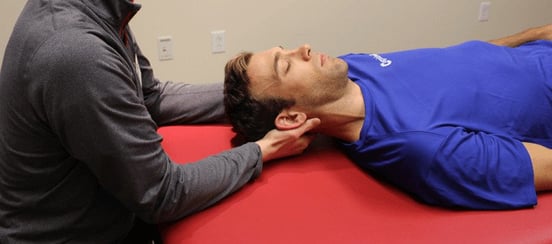
At Cognitive FX, we take a multidisciplinary approach to treating brain injury and concussion patients. This means we employ various therapies during your treatment at our center to ensure you benefit from the most improvements possible for your health care.
One of the issues we explain to our patients is that their real-life problems are largely caused by issues with something called “neurovascular coupling,” or NVC.
Neurovascular coupling is the connection between brain cells (neurons) and blood vessels (vascular system). In a healthy brain, the system that delivers blood to the exact region of the brain needed to do a particular task is very efficient. This helps the brain complete the task by providing additional blood to brain cells so they can continue working.
In an injured brain, this process can get interrupted, and neurovascular coupling dysregulation is one of the root causes of concussion symptoms.
So, before treatment begins, we locate specific areas of neurovascular coupling dysfunction in the brain using a form of fMRI called functional neurocognitive imaging (fNCI).This allows us to see which areas of the brain are suffering from a neurovascular coupling issue so we can formulate a customized treatment plan.
Part of preparing your brain for therapy involves getting blood flowing well throughout it. Aerobic exercise provides extra oxygen to the brain, which in turn gives it a post exercise cognitive boost (PECB). This means that essential neurotransmitters and proteins, which help promote blood flow, are released in the brain, allowing it to perform cognitive tasks for longer periods of time.
According to research published with the National Institutes of Health: “[Cognitive rehabilitation] has always shown more benefits when administered as the part of the multidisciplinary/interdisciplinary approach. Multidisciplinary team approach encompasses physician, neuropsychologists, speech-language pathologists, occupational therapists, physical therapists, and social workers.”
At Cognitive FX, we know this. Our experienced treatment team includes a neuropsychologist, a neuroscientist, a neuroradiologist, a psychologist, and numerous therapists who are experienced working with post-concussion syndrome. And that’s why we designed our Enhanced Performance in Cognition (EPIC) Treatment to combine key therapies that provide our patients with the best results we can.
It’s our unique combination of aerobic exercise, neuromuscular therapy, sensorimotor therapy, cognitive exercises, balance therapy, vision therapy, and occupational therapy that makes our EPIC treatment work well.
If you or a loved one are suffering from lingering symptoms after a traumatic brain injury, you’re not alone. We can help. 95% of our patients experience statistically verified restoration of brain function. Their symptoms improve, on average, by 75% in just one week.
Book a consultation with our team to learn if you are eligible for treatment.

